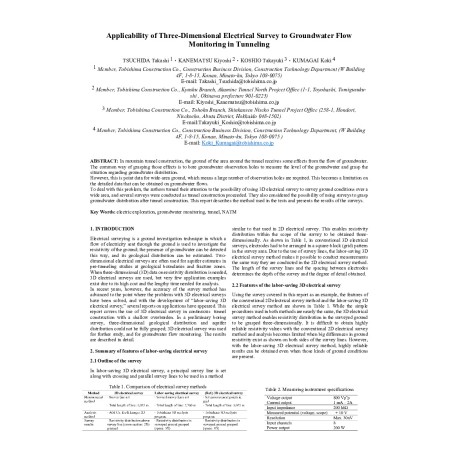Cart
0
0
No document
0,00 €
Total
Document successfully added to your shopping cart
Quantity
Total
There are 0 items in your cart.
There is 1 item in your cart.
Total documents
Total shipping
To be determined
Total
Search & filter
Search for a publication
Search & filter
Applicability of Three-Dimensional Electrical Survey to Groundwater Flow
Applicability_of_Three-Dimension
K. Kiyoshi / Koshio Takayuki / Kumagai Koki
In mountain tunnel construction, the ground of the area around the tunnel receives some effects from the flow of groundwater. The common way of grasping those effects is to bore groundwater observation holes to measure the level of the groundwater and grasp the situation regarding groundwater distribution. However, this is point data for wide-area ground, which means a large number of observation holes are required. This becomes a limitation on the detailed data that can be obtained on groundwater flows. To deal with this problem, the authors turned their attention to the possibility of using 3D electrical survey to survey ground conditions over a wide area, and several surveys were conducted as tunnel construction proceeded. They also considered the possibility of using surveys to grasp groundwater distribution after tunnel construction. This report describes the method used in the tests and presents the results of the surveys. Key Words: electric exploration, groundwater monitoring, tunnel, NATM similar to that used in 2D electrical survey. This enables resistivity distribution within the scope of the survey to be obtained threeElectrical surveying is a ground investigation technique in which a dimensionally. As shown in Table 1, in conventional 3D electrical flow of electricity sent through the ground is used to investigate the surveys, electrodes had to be arranged in a square-block (grid) pattern resistivity of the ground; the presence of groundwater can be detected in the survey area. Due to the use of survey lines, the labor-saving 3D this way, and its geological distribution can be estimated. Two- electrical survey method makes it possible to conduct measurements dimensional electrical surveys are often used for aquifer estimates in the same way they are conducted in the 2D electrical survey method. pre-tunneling studies at geological boundaries and fracture zones. The length of the survey lines and the spacing between electrodes When three-dimensional (3D) data on resistivity distribution is needed, determines the depth of the survey and the degree of detail obtained. 3D electrical surveys are used, but very few application examples exist due to its high cost and the lengthy time needed for analysis. 2.2 Features of the labor-saving 3D electrical survey In recent years, however, the accuracy of the survey method has advanced to the point where the problems with 3D electrical surveys Using the survey covered in this report as an example, the features of have been solved, and with the development of “labor-saving 3D the conventional 2D electrical survey method and the labor-saving 3D electrical survey,” several reports on applications have appeared. This electrical survey method are shown in Table 1. While the simple report covers the use of 3D electrical survey in continuous tunnel procedures used in both methods are nearly the same, the 3D electrical construction with a shallow overburden.




